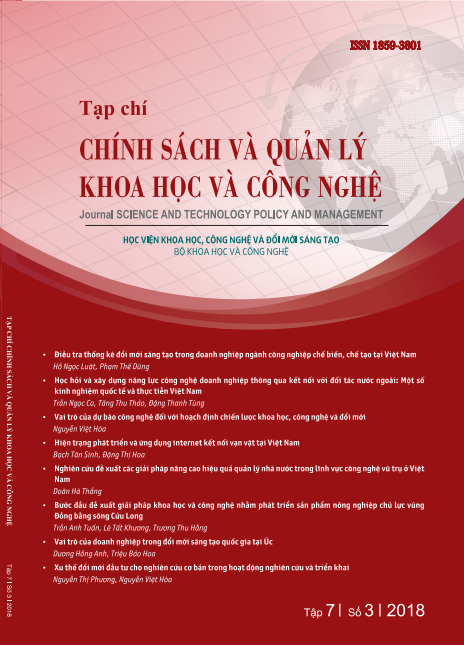Role of technology forecasts for planning of science, technology and innovation strategies
Keywords:
Technology forecast, Science, technology and innovation strategyAbstract
Planning science, technology and innovation strategies (abbreviation of strategic planning) in a new context that promotes engagement with science, technology and innovation forecasts. The forecast provides scientific foundation based on scientific methodology, reflects honestly and objectively on the movement and development of science, technology and innovation and the trend of science, technology and innovation will develop in the future. As a result, the highly valuable product of the forecast is to model, scenerio or provide information and data to create a picture of the development trend of science, technology and innovation in the future for strategic planners to choose the most optimal model or scenario into the strategy.
The scope of research on strategic planning and forecasting of science, technology and innovation is very wide, but this article will limit and focuse on three main contents: (i) Reasoning the role of technology forecasts with strategic planning; (ii) Methodology of technology forecasting for strategic planning; (iii) Some of the issues that are suggestive for Vietnam.
Code: 18070101
Downloads
References
1. Nguyễn Việt Hòa, 2013. Nghiên cứu thực trạng, nhận dạng những khó khăn và thuận lợi của dự báo KH&CN ở Việt Nam. Đề tài cấp cơ sở, Viện Chiến lược và Chính sách KH&CN.
2. Hoàng Minh, Nguyễn Võ Hưng, Nguyễn Thị Phương Mai, Bùi Thế Duy, 2017. “Kết quả chỉ số đổi mới sáng tạo toàn cầu của Việt Nam năm 2017, ý nghĩa và các vấn đề đặt ra”. Tạp chí Chính sách và Quản lý KH&CN, Tập 6, Số 2, 2017.
Tiếng Anh:
3. OECD, 2016. National strategies for science, technology and innovation.
4. National Academies Press, 2018. Persistent Forecasting of Disruptive Technologies. 500 Fifth Street, N.W. Washington, DC 20001.
5. A Review Ayse Kaya Firat Wei Lee Woon Stuart Madnick (2008): Technological Forecasting -Working Paper CISL# 2008-15.
6. Global Forum on Agricultural Research-GFAR, 2015. The Foresight method for scenario building. Published on Feb 23, 2015.
7. Protiviti Inc, 2018. KnowledgeLeader-Copyright Protiviti Inc. 2018. EOE All Rights Reserved.
8. Martino, Joseph, 1983. Technological forecasting for decision-making (2nd). AmsterdarnINew York: North-Holland.
9. Armstrong JS, 1985. Long-Range Forecasting. 2nd edition
10. SpyrosMakridakis, 1996. “Forecasting: Iits role and value for planning and strategy”. International Journal of Forecasting, Volume 12, Issue 4, Pages 513-537.
11. Andrew May, 2001. “Science forecasting: predicting the unpredictable”. Journal of Defence Science, Vol. 6 No. 2.
12. Vanston, John H, 2003. “Better forecasts, better plans, better results: Enhance the validity and credibility of your forecasts by structuring them in accordance with the five different ways people view the future”. Research-Technology Management 46.1.
13. Clive W.J.Granger, Yongil Jeon, 2007. Long-term forecasting and evaluation.
14. Ayse Kaya Firat, Wei Lee Woon, Stuart Madnick, 2008. Technological ForecastingAReview. Working Paper CISL# 2008-15.
15. Daekook Kang, Wooseok Jang, Hyeonjeong Lee, and Hyun Joung No, 2013. “A Review on Technology Forecasting Methods and Their Application Area”. World Academy of Science, Engineering and Technology International. Journal of Industrial and Manufacturing Engineering, Vol.7, No.4, 2013.
16. Leslie A.Pal, 2014. Beyond Policy Analysis, Public Issue Management in Turbulent Times, (5th edition), Canada.
17. Moonjung ChoiI, Han-Lim Choi, 2015. “Foresight for Science and Technology Priority Setting in Korea”. Foresight and STI Governance. Vol. 9 No 3 2015.
18. Serkan Altuntas, Turkay Dereli, Andrew Kusiak, 2015. Forecasting technology success based on patent data. © 2015 Elsevier Inc. All rights reserved.
19. Gilman G.Louie, 2018. Chair Committee on Forecasting Future Disruptive Technologies.
Downloads
Published
How to Cite
Issue
Section
License
Authors who publish with this journal agree to the following terms:
- Authors retain copyright and grant the journal right of first publication with the work simultaneously licensed under a Creative Commons Attribution License that allows others to share the work with an acknowledgement of the work's authorship and initial publication in this journal.
- Authors are able to enter into separate, additional contractual arrangements for the non-exclusive distribution of the journal's published version of the work (e.g., post it to an institutional repository or publish it in a book), with an acknowledgement of its initial publication in this journal.
- Authors are permitted and encouraged to post their work online (e.g., in institutional repositories or on their website) prior to and during the submission process, as it can lead to productive exchanges, as well as earlier and greater citation of published work (See The Effect of Open Access).

